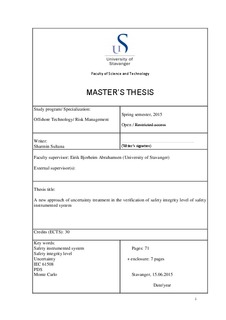| dc.description.abstract | Reliability is very important aspect of any safety instrumented system. The standard IEC 61508, widely accepted in field of reliability of instrumented systems, entails the quantification of achieved risk reduction to be expressed as a safety integrity level (SIL). The required SIL can be determined by various methods like risk graph method, risk matrix, markov process, petri-nets. The standard also instruct that reliability data uncertainty should be taken into account when calculating target PFDavg.
Even in the recent past, it was common practice to overlook the existence of uncertainty. Uncertainty encountered during design, operation and maintenance should be an integral part of the decision making process, not an afterthought and should be treated with the same attention as the other requirements. The main objective of this research is to develop a systematic approach to assess the effect of uncertainty on SIL level, where SIL is determined by PDS method.
The research was motivated by five research questions: 1) How to propagate uncertainty in SIL level, where SIL is calculated by PDS method? 2) Is objective uncertainty analysis established in literature is adequate for modern system? 3) What are the limitations of this objective approach? 4) How can MTO perspectives and operational constraints be included in uncertainty analysis? 5) What should be the basis for overall decision making? To answer these questions, a literature study was performed to review existing theories, models and their prospects. The study attracts the focus to the point that there is a lack of objective along with subjective uncertainty analysis for PDS method. Few works has been done to verify uncertainty in SIL verification where SIL has been determined by reliability block diagram or risk graph method proposed by IEC standard.
PDS method uses approximated formula for SIL calculation and is said to follow conservative approach. This means calculated SIL value will show conservative result compared to the results determined by other methods. One may argue about the necessity of uncertainty analysis after getting such conservative result. Logic for this further study is to establish a structured framework for the analysis. Objective quantitative analysis is carried out with Monte Carlo simulation using @risk software applied to a practical case application of subsea well isolation system. The simulation case is checked with one programming language (Scilab) to check consistency of the result of @risk. However, this thesis does not focus on the accuracy of the result, rather more focus is given to the development of framework.
During the literature study, it is also observed that there is a lack of literature on the inclusion of MTO perspective and operational constraint in uncertainty analysis. It is termed as background knowledge in risk management point of view. Exception is the paper of Abrahamsen and Røed (2011) where the authors have proposed a qualitative uncertainty assessment of background knowledge in SIL verification. Schönbeck, Rausand, and Rouvroye (2010) in their paper also presented an approach to include human and organization factor in the operation phase of SIS. Part of this research is motivated by these two papers. Now a days wide spread research is going on to include human-organizational factors in risk analysis or others. Aramis project, bora approach, work process analysis method are such examples. A quantification method is proposed to take into account of uncertainty in background knowledge.
Final task in reliability analysis is decision making of SIL compliance. If it does not meet the requirement, one option is to modify SIS architectural configuration or modifying test interval, using highly reliable equipment. However the question may arise about the potential contribution of uncertainty result in decision making, use of suitable tool and proper phase to use. Is the result only carry significance or other factors need to be considered also? This thesis tries to cover answers of all these questions in a systematic way. Analysis are carried out with the help of a case study. To draw confident conclusions from the development, it is necessary to verify the methods with more case applications and see their effects applied in practice. Recommendations for further work are included in the final part of the thesis.
Uncertainty analysis should not be considered as an unnecessary burden, rather it should be thought as a mean to be informed about risk in the decision process that will be helpful in a broader sense to reduce risk. | nb_NO |
